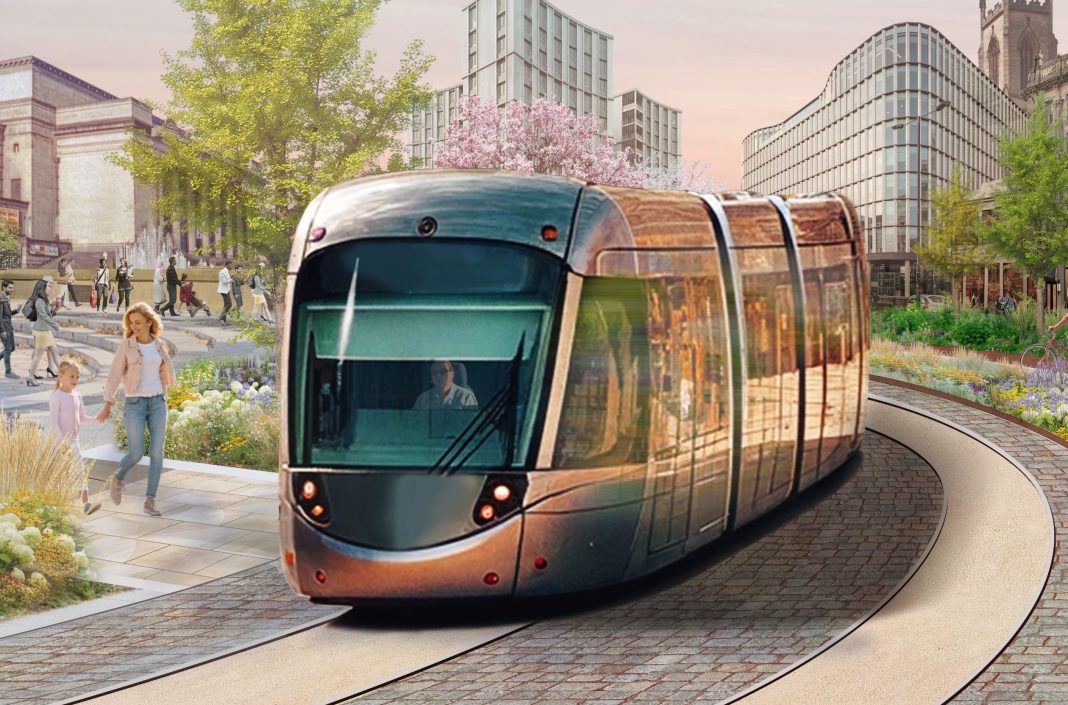Leeds City Council is backing the first phase of West Yorkshire’s mass transit scheme, in a report due to go before senior councillors next week.
The West Yorkshire Combined Authority is currently consulting on the first phase of its mass transit scheme, which would see tram routes created between St James’ Hospital and the White Rose office park and shopping centre, and between Leeds and Bradford.
A report to the Leeds City Council’s executive board, to be considered at its meeting at Civic Hall on Wednesday 18 September, states that the council recognises the ‘strategic importance’ of mass transit across Leeds and West Yorkshire in improving transport connections and accelerating economic growth and regeneration.
This includes ‘unlocking of new housing growth opportunities across the city’ and ‘bringing people within easier reach of jobs and opportunities’, along with connecting people with education, health and local centres in addition to social and leisure destinations in the city centre.
The report also states that mass transit ‘will play a critical role in helping Leeds to be the city where you don’t need a car, encouraging mode shift from private car use to reduce congestion and meet the council’s carbon net zero targets’.
The combined authority’s consultation options splits the possible mass transit route into three sections – Leeds city centre and South Leeds, which together make up the ‘Leeds Line’, and the ‘Bradford Line’.
There are four options for the Leeds city centre route, between St James’ Hospital and the River Aire at Victoria Bridge.
There are three options for South Leeds route, which would join the city centre route at Victoria Bridge and end at the White Rose Shopping Centre via either Holbeck and Elland Road or along the A653 Dewsbury Road.
The Bradford Line options would connect Leeds and Bradford using three different routes between either Stanningley or Pudsey, and either Armley or Wortley.
The report states the council’s preference for Leeds city centre route known as L1 via East Parade and Infirmary Street, connecting to the South Leeds route known as L6 which would travel via Elland Road, Elland Road Stadium and Ring Road Beeston to the White Rose site.
The report states that the council supports routes that connect to these destinations along with the universities, hospitals, existing housing developments and the Innovation Arc, and ‘offer opportunities to accelerate urban regeneration… and be a catalyst for wider change by helping to unlock brownfield development and placemaking that contributes to new housing delivery and economic growth’.
The report goes on to state that mass transit ‘has the potential to radically change access to the south of the city and particularly the corridor comprising Elland Road, the football stadium, White Rose Office Park and White Rose Shopping Centre, and outer south Leeds, linking to growth points in Kirklees’. The report suggests that options which follow routes through Middleton similar to those in the previously-proposed New Generation Transport (NGT) scheme would be ‘sub-optimal’ compared to routes which connect to Elland Road, and previous ‘negative feedback’ about the NGT routes should be taken into account.
The report recognises the importance of improving connectivity between the two largest cities in West Yorkshire and the ‘clear regeneration opportunities for key settlements along the route’.
The council also wants to ensure that ‘centres like Pudsey gain maximum benefit from the provision of an enhanced transport link’ and supports improved connections between the city centre, Pudsey and Bradford.
However, the report does not outline a specific preference for any of the three Bradford Line options at this stage, stating that the council would welcome ‘further conversations on the design development with WYCA to fully inform future considerations on a preferred route’. This includes understanding how any route would integrate and impact on the existing railway and Northern Powerhouse Rail proposals, how any disruption to local highways would be minimised, and how mass transit would serve communities along the route.
Councillor Jonathan Pryor, Leeds City Council’s deputy leader and executive member for economy, transport and sustainable development, said: “We are extremely supportive of mass transit in Leeds and the wider West Yorkshire region. It will improve transport connections, bring people within easier reach of jobs and opportunities, boost our economic growth and regeneration ambitions, and have a positive impact on people’s overall quality of life.
“Improved connectivity with our neighbours in Bradford is incredibly important in boosting both cities’ economic potential and is something that we would like to see delivered as soon as possible.
“We recognise that the combined authority’s proposals are at an early stage, and as such we require greater clarity in some key areas, but overall we are keen to realise mass transit and its benefits for our city and the wider region as a whole.”
The executive board report outlines the council’s technical response to the combined authority’s first phase of consultation. Following approval at next week’s executive board meeting, the council will provide its response to the combined authority. The combined authority’s first phase mass transit consultation closes on 30 September 2024.



